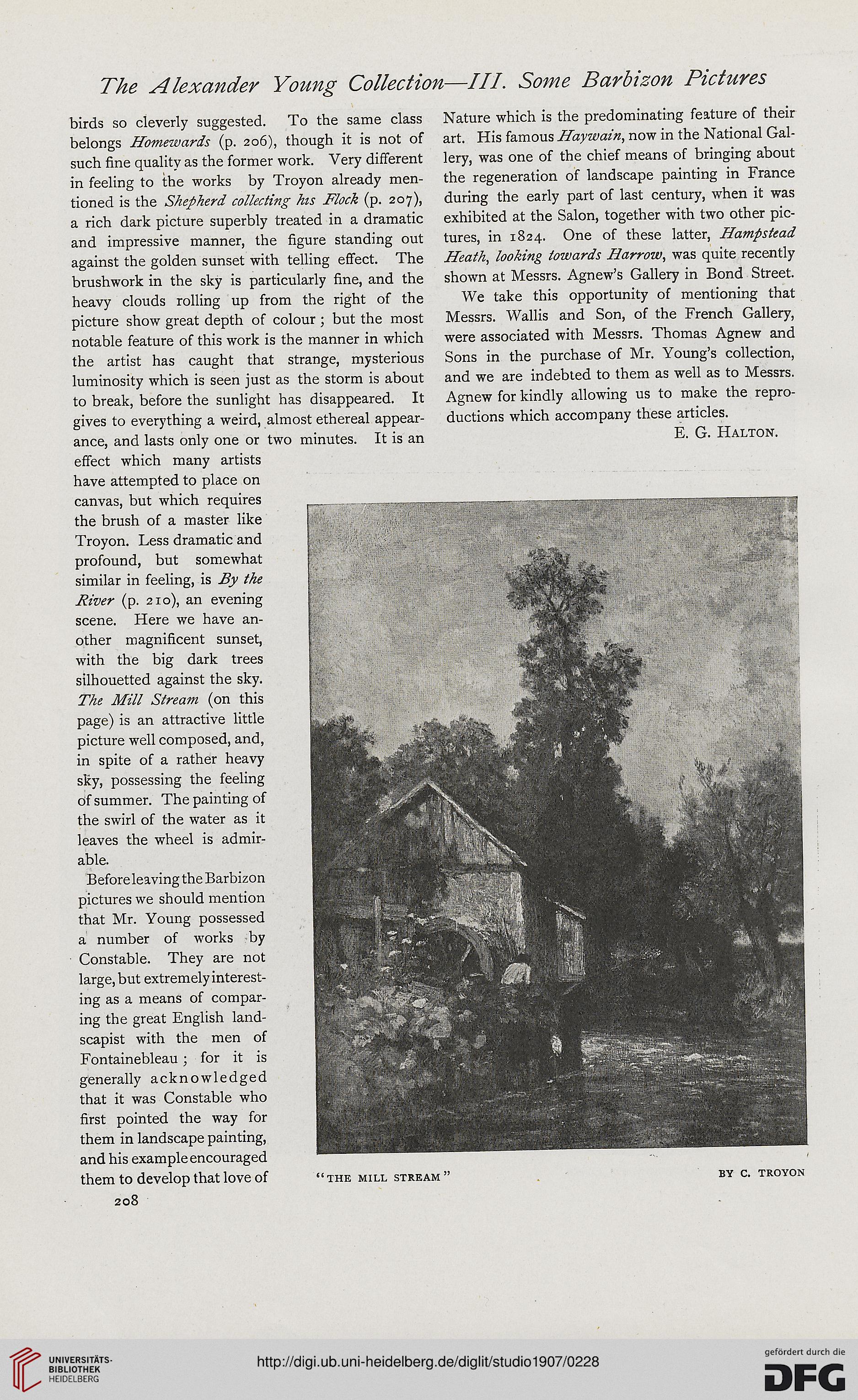The Alexander Young Collection—III. Some Barbizon Pictures
birds so cleverly suggested. To the same class Nature which is the predominating feature of their
belongs Homewards (p. 206), though it is not of art. His famous Haywain, now in the National Gal-
such fine quality as the former work. Very different lery, was one of the chief means of bringing about
in feeling to the works by Troyon already men- the regeneration of landscape painting in France
tioned is the Shepherd collecting his Flock (p. 207), during the early part of last century, when it was
a rich dark picture superbly treated in a dramatic exhibited at the Salon, together with two other pic-
and impressive manner, the figure standing out tures, in 1824. One of these latter, Hampstead
against the golden sunset with telling effect. The Heath, looking towards Harrow, was quite recently
brushwork in the sky is particularly fine, and the shown at Messrs. Agnew's Gallery in Bond Street,
heavy clouds rolling up from the right of the We take this opportunity of mentioning that
picture show great depth of colour; but the most Messrs. Wallis and Son, of the French Gallery,
notable feature of this work is the manner in which were associated with Messrs. Thomas Agnew and
the artist has caught that strange, mysterious Sons in the purchase of Mr. Young's collection,
luminosity which is seen just as the storm is about and we are indebted to them as well as to Messrs.
to break, before the sunlight has disappeared. It Agnew for kindly allowing us to make the repro-
gives to everything a weird, almost ethereal appear- ductions which accompany these articles,
ance, and lasts only one or two minutes. It is an E. G. Halton.
effect which many artists
have attempted to place on
canvas, but which requires
the brush of a master like
Troyon. Less dramatic and
profound, but somewhat
similar in feeling, is By the
River (p. 210), an evening
scene. Here we have an-
other magnificent sunset,
with the big dark trees
silhouetted against the sky.
The Mill Stream (on this
page) is an attractive little
picture well composed, and,
in spite of a rather heavy
sky, possessing the feeling
of summer. The painting of
the swirl of the water as it
leaves the wheel is admir-
able.
Beforeleaving the Barbizon
pictures we should mention
that Mr. Young possessed
a number of works by
Constable. They are not
large, but extremely interest-
ing as a means of compar-
ing the great English land-
scapist with the men of
Fontainebleau; for it is
generally acknowledged
that it was Constable who
first pointed the way for
them in landscape painting,
and his example encouraged
them to develop that love of "the mill stream" by c. troyon
208
birds so cleverly suggested. To the same class Nature which is the predominating feature of their
belongs Homewards (p. 206), though it is not of art. His famous Haywain, now in the National Gal-
such fine quality as the former work. Very different lery, was one of the chief means of bringing about
in feeling to the works by Troyon already men- the regeneration of landscape painting in France
tioned is the Shepherd collecting his Flock (p. 207), during the early part of last century, when it was
a rich dark picture superbly treated in a dramatic exhibited at the Salon, together with two other pic-
and impressive manner, the figure standing out tures, in 1824. One of these latter, Hampstead
against the golden sunset with telling effect. The Heath, looking towards Harrow, was quite recently
brushwork in the sky is particularly fine, and the shown at Messrs. Agnew's Gallery in Bond Street,
heavy clouds rolling up from the right of the We take this opportunity of mentioning that
picture show great depth of colour; but the most Messrs. Wallis and Son, of the French Gallery,
notable feature of this work is the manner in which were associated with Messrs. Thomas Agnew and
the artist has caught that strange, mysterious Sons in the purchase of Mr. Young's collection,
luminosity which is seen just as the storm is about and we are indebted to them as well as to Messrs.
to break, before the sunlight has disappeared. It Agnew for kindly allowing us to make the repro-
gives to everything a weird, almost ethereal appear- ductions which accompany these articles,
ance, and lasts only one or two minutes. It is an E. G. Halton.
effect which many artists
have attempted to place on
canvas, but which requires
the brush of a master like
Troyon. Less dramatic and
profound, but somewhat
similar in feeling, is By the
River (p. 210), an evening
scene. Here we have an-
other magnificent sunset,
with the big dark trees
silhouetted against the sky.
The Mill Stream (on this
page) is an attractive little
picture well composed, and,
in spite of a rather heavy
sky, possessing the feeling
of summer. The painting of
the swirl of the water as it
leaves the wheel is admir-
able.
Beforeleaving the Barbizon
pictures we should mention
that Mr. Young possessed
a number of works by
Constable. They are not
large, but extremely interest-
ing as a means of compar-
ing the great English land-
scapist with the men of
Fontainebleau; for it is
generally acknowledged
that it was Constable who
first pointed the way for
them in landscape painting,
and his example encouraged
them to develop that love of "the mill stream" by c. troyon
208




